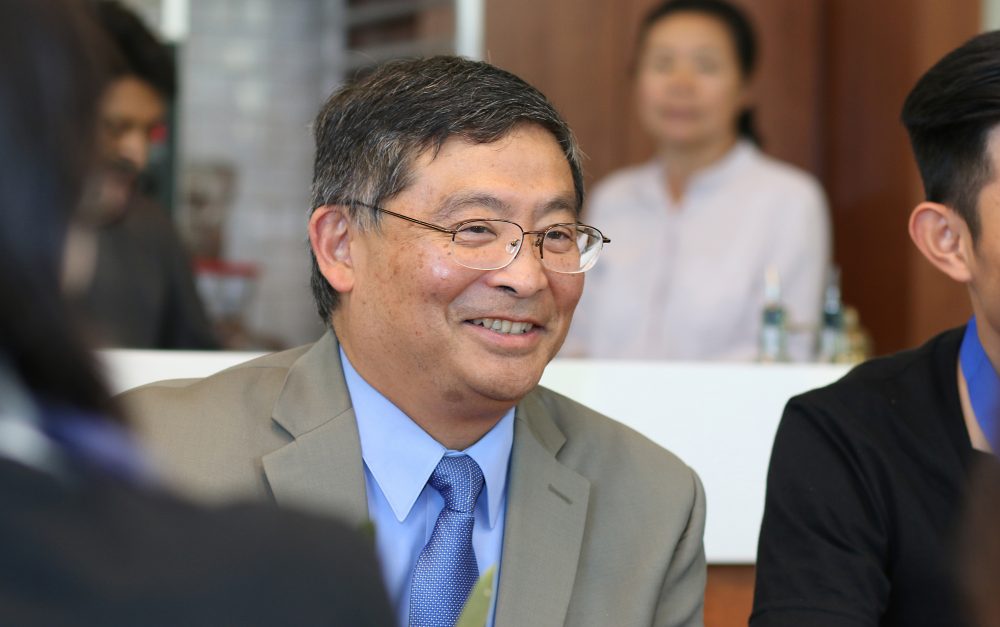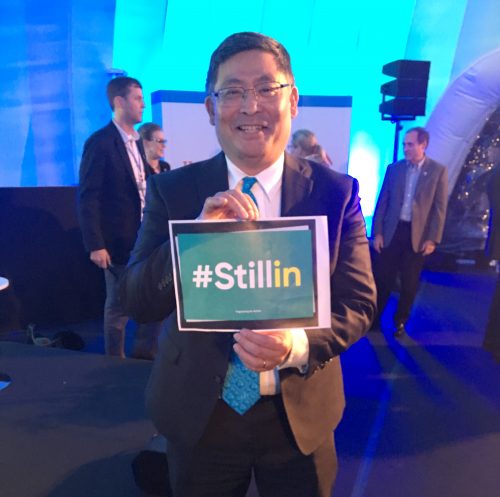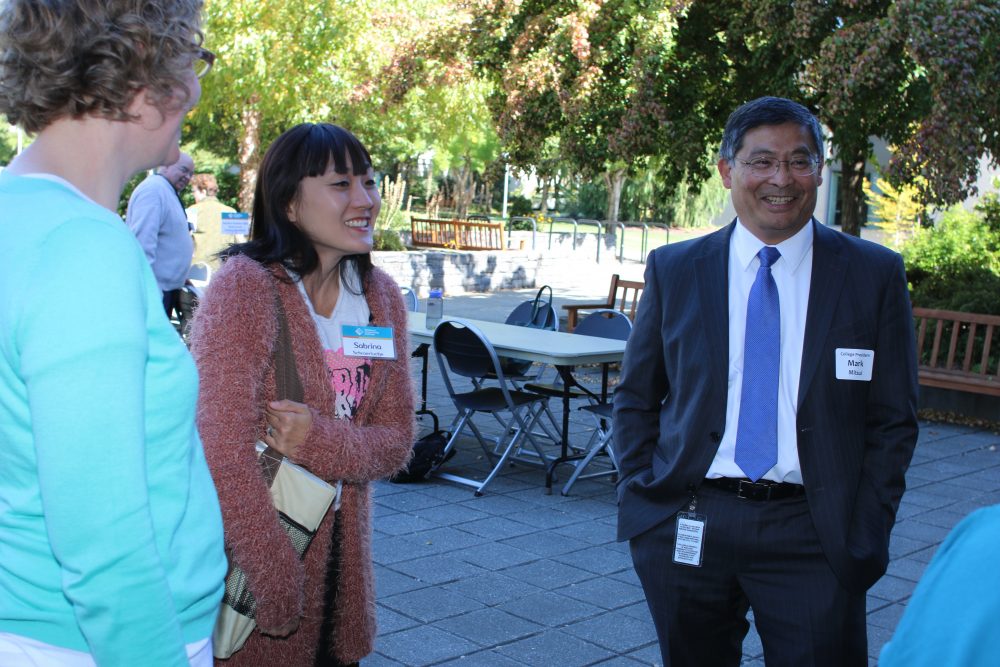This content was published: January 21, 2018. Phone numbers, email addresses, and other information may have changed.
Embracing and creating opportunity: Mark Mitsui excited for PCC’s future
Photos and Story by Kate Chester
 Portland Community College President Mark Mitsui has a vision for the college’s future — and it’s a very bright future.
Portland Community College President Mark Mitsui has a vision for the college’s future — and it’s a very bright future.
In the 15 months since joining PCC, Mitsui has helped the college pass a pivotal bond measure, presented at a world climate conference in Germany, created a comprehensive work plan outlining key strategic goals and objectives, supported PCC’s membership to a national network of community colleges — Achieving the Dream — focused on helping more students succeed academically, and committed PCC to the development of a culture dedicated to equitable student success.
With the start of the new year, PCC’s busy leader reflects on a successful 2017 and talks about his vision for 2018.
What was the biggest success of 2017?
Mark Mitsui: Last year produced an array of successes for Portland Community College, and one of the biggest was the bond campaign. A big “thank you” goes out to voters within PCC’s service area, who approved the college’s bond measure in the November election. PCC provides an affordable option to many students who would not otherwise be able to attend college. The voters’ investment and support of PCC enables us to educate the workforce of tomorrow – and this benefits our entire community.
Last year really seemed to be the year the college was recognized for its sustainable practices. Tell us more.
Mitsui: Yes. PCC is doing its part – for instance, reducing our energy consumption by 65 percent per square foot since 2006. Our efforts were honored this fall as PCC received the Second Nature Climate Leadership Award for two-year colleges, a national recognition of innovative and advanced leadership in sustainability and climate mitigation. This was followed by an invitation to attend a conference in Bonn, Germany, as a part of “We Are Still In,” a non-federal, subnational group committed to upholding the Paris Climate Agreement. The conference hosted the next round of United Nations climate negotiations. WASI, meanwhile, organized the U.S. Climate Action Center, a first-ever pavilion and forum for American leaders to convene and share their contributions to address climate change. Witnessing such international cooperation was inspiring, and our participation made it clear that PCC, and higher education overall, plays an important role in the search for solutions.
How important was it for PCC to establish a DREAMer Center?
Mitsui: Very, because in the wake of federal policy changes, Deferred Action for Childhood Arrivals (DACA) protection has been jeopardized.
For the past five years, DACA has given nearly 800,000 young Americans called “DREAMers,” who were brought to the U.S. as children, the legal protections they need to work and study here despite the immigration status of their parents. Through the Oregon Immigrant and Refugee Funders Collaborative, Meyer Memorial Trust awarded PCC’s Foundation a $50,000 grant to launch the DREAM Center (Development, Relief, and Education for Alien Minors) at our Rock Creek Campus.
The new center, which will be instrumental in serving greater Washington County, is the first of its kind at any Oregon community college or university. It will provide outreach, education, advocacy and community resources for undocumented and DACA students and their families.
What is a key goal for the year ahead?
Mitsui: Our goal in 2018 is to become Oregon’s “Opportunity College,” offering an educational experience that widens the pathway to opportunity for all of the students we serve. We know that two-thirds of all jobs by the year 2020 will require some level of postsecondary education or specialized training. We also know that community college students have to work more and study less due to their financial situations; many students also struggle with food and housing insecurity. Our task, then, is to make higher education both accessible and feasible, so that students can afford to complete their studies.
Are there tools or programs the college can tap to accomplish this, or to enhance work already under way?
Mitsui: Yes. Research shows wrap-around support services – advising, tutoring, coaching, mentoring – that complement students’ academic programs improve their chances for academic success and graduation. And graduating increases their chance for employment, enabling them to build better lives for themselves and their families.
Using this data, PCC has nested identified services into a handful of innovative programs that empower students through personalized support – with astounding results. Future Connect, our scholarship and support program for low-income, first generation PCC students, is one such example. Future Connect boosts college completion or transfer rates within three years by 11 percent, thanks in great part to embedded wrap-around services.
Please share progress made surrounding PCC’s commitment to equitable student success.
Mitsui: Last year PCC has joined Achieving the Dream, a non-governmental, national community college movement. Like PCC, ATD believes that access to high quality education, in an inclusive environment, is imperative for the continued advancement of a strong democracy and workforce. With the help of ATD resources, our college will be better positioned to increase student success rates, without lowering academic standards, and identify and bridge key regional workforce skills gaps so that students are prepared for success in college, work and life.
We’re tailoring ATD’s offerings to fit PCC and our needs, and calling our local work YESS — “Yes to Equitable Student Success.” YESS is the frame for our aligned set of strategies to enhance solutions that help students overcome barriers and succeed equitably.
How critical is PCC to the community at large — and to the state?
Mitsui: Education changes lives and opens doors to opportunity that benefit the greater community. A recent economic impact study shows a return of $3.70 in higher future earnings for every dollar that PCC students invest in their education. Taxpayers and the community at large see similar results: Taxpayers experience a 5.3 benefit-cost ratio, while PCC’s service area nets $12.50 in benefits for every dollar invested in a PCC education due to reduced crime, lower unemployment, and increased health and well-being.
The college clearly plays a crucial role in the success — economic and otherwise — of our greater community. Knowing this, PCC enters 2018 with optimism and hope, and an aim to contribute to a brighter future for Oregon.



Please put up signs REMINDING PEOPLE NOT TO TALK AT FULL VOLUME. I am at SE campus trying to study across from students talking at full volume.
Some of this may be people who were not raised here and do not know this is disturbing to others.
Frustrating no librarians to stop this.